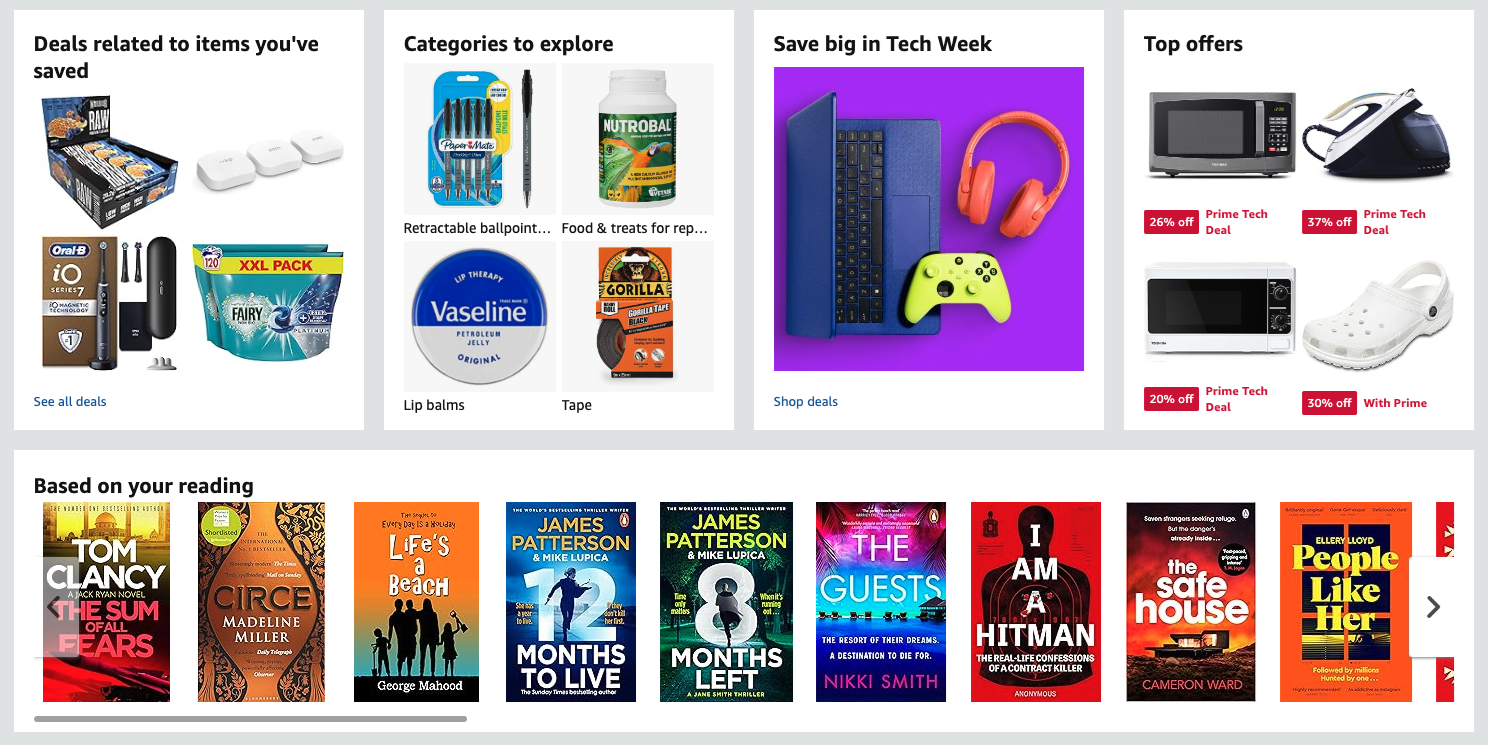Table of contents
- What is eCommerce personalisation?
- What does eCommerce personalisation look like in practice?
- 3 great examples of eCommerce personalisation
- Why eCommerce personalisation matters
- Best Practices for Implementing eCommerce Personalisation
- Can you personalise the delivery experience?
- What does personalisation look like for your brand?
Standing in today’s crowded online marketplace is no longer just about having the best products or the lowest prices. Consumers everywhere expect meaningful shopping experiences that feel crafted just for them.
That’s where eCommerce personalisation comes in. It transforms generic websites and emails into customer-centric experiences that recommend relevant products and build genuine connections.
In this article, we’ll explore what eCommerce personalisation looks like, how it works and how you can start delivering personalised shopping experiences.
What is eCommerce personalisation?
Let’s start with a definition: eCommerce personalisation uses customer data to create shopping experiences that better fulfill an individual’s preferences, behaviours and needs.
Rather than delivering the same content to every customer, shoppers see tailored offers, messaging and product recommendations. It leads to more engagement and higher conversions.
What does eCommerce personalisation look like in practice?
Ecommerce personalisation takes many forms, whether you’re browsing your favourite brand’s website or opening a promotional email. Here are some of the most common applications:
- Product recommendations based on browsing history, past purchases and other use behaviours
- Dynamic homepage layouts based on previous browsing history
- Personalised search results that take into account your browsing history
- Targeted email marketing offers based on the items in your shopping cart
- Customised pricing that offers savings to loyal customers
- Tailored checkout processes that remember your shipping address and payment details
As you can see, most personalisation efforts use browsing and purchase history to tailor the shopping experience, but eCommerce personalisation isn’t limited to known customers with accounts. Modern personalisation tools can deliver contextually relevant experiences to anonymous visitors, too.
3 great examples of eCommerce personalisation
While it’s great to understand the eCommerce personalisation theory, nothing beats seeing it in practice. To that end, here are three examples of effective eCommerce personalisation that UK retailers can emulate.
1. On-site product recommendations
If you’ve ever shopped on Amazon — and let’s be honest, who hasn’t? — then you’ll have seen personalised product recommendations on the site’s homepage.
Here’s what they look like:

These recommendations work by reminding shoppers of previous shopping experiences and suggesting new items based on their behaviour. Shoppers can find their next purchase without leaving the homepage.
2. Abandoned cart emails
Personalised abandoned cart emails are targeted messages that stores send to shoppers who add items to their basket but leave without purchasing. Here’s a great example from U.S. retailer Huckberry:

These emails work because they show customers what they are missing out on. Images, product descriptions and pricing information create FOMO and encourage users to head back online to complete their purchase.
Bonus tip: These emails are even more powerful when you include a personalised discount for shoppers!
3. Retargeting ads
You can even deliver eCommerce personalisation through your paid ads strategy. Personalised retargeting ads dynamically display products based on the user’s browsing behaviour and past interactions.
Here’s an example from Casper:

Showing products that users have already clicked on makes these ads highly relevant and engaging. They resonate with customers, encouraging purchases that may not have otherwise occurred.
Why eCommerce personalisation matters
There’s a whole host of reasons retailers should implement eCommerce personalisation tactics, especially in a saturated and competitive market like the UK.
Here are the most important benefits of eCommerce personalisation:
- Increase sales. Personalisation directly influences purchasing decisions by showing customers products they're most likely to buy. When shoppers see relevant recommendations, they're more likely to add items to their cart and complete purchases.
- Enhanced customer loyalty. When customers feel understood, they develop stronger connections with brands. Personalisation creates these connections by demonstrating that you understand and value individual customer needs.
- Fewer cart abandonments. Personalised shopping experiences address common reasons for cart abandonment by ensuring customers see products they genuinely want, at prices they're willing to pay, with shipping options that meet their expectations.
- Competitive differentiation. Personalisation offers a way to stand out from competitors. While price and selection remain important, the quality of the shopping experience increasingly determines where consumers choose to shop.
In short, eCommerce personalisation transforms shopping experiences from generic to highly relevant, directly driving better business outcomes and stronger customer relationships.
Best Practices for Implementing eCommerce Personalisation
Successfully implementing personalisation requires careful planning and execution. Here are key best practices for online retailers:
1. Start with clear objectives
Be clear about what you want to achieve with eCommerce personalisation before you start. Whether it's increasing average order value, improving conversion rates, or enhancing customer retention, having clear objectives will guide your approach and help measure success.
2. Collect and unify customer data
Effective personalisation requires a unified view of your customers. Implement a customer data platform or CRM to collect customer data while respecting privacy regulations, like GDPR.
Focus on collecting as much first-party data as possible. Track how users navigate your site, which products they click on and where they spend their time. This will be vital for effective personalisation.
3. Leverage AI and machine learning
AI and machine learning are essential for delivering personalisation at scale. AI can analyse vast amounts of customer data to identify insights human analysts might miss and deliver real-time personalisation based on current browsing behaviour.
4. Ensure cross-channel consistency
Customers expect consistent experiences, regardless of how they interact with your brand. That means personalisation across every touchpoint.
So, if you’re personalising your online store, try to also personalise emails, your mobile app and customer service interactions, too.
5. Respect privacy and build trust
Personalisation can be highly effective, but it can also feel intrusive. That’s why it’s important to abide by data privacy laws and let customers know exactly what data you collect and how you use it. If in doubt, don’t use personalisation in a way that feels intrusive.
Can you personalise the delivery experience?
As one of the leading cross-border delivery companies, it would be remiss of us not to discuss how to extend personalisation beyond the checkout. Here are three ways you can personalise eCommerce delivery and returns:
- Delivery options. Retailers can automatically offer parcel drop-off options using the customer’s location. If they regularly choose a different locker in another part of town, retailers can adjust future suggestions accordingly.
- Localised delivery updates. A simple way to personalise the cross-border delivery experience is to offer shipping updates in the customer’s local language. This tactic — one that Pro Carrier does by default — is an easy way to delight customers while keeping them informed.
- Returns and product exchanges. As with deliveries, retailers can offer location-specific drop-off points for returns. They can go even further, however, and offer personalised exchange recommendations based on the customer’s history.
As you can see, there are plenty of opportunities to personalise every part of the eCommerce experience. You just have to look for them or work with a partner who makes personalisation easy.
What does personalisation look like for your brand?
Personalisation has quickly evolved from a standout feature to an essential strategy for online success. As consumer expectations continue to rise and technology becomes more sophisticated and affordable, the levels of personalisation brands can offer will only increase.
Retailers that create bespoke, relevant experiences across the entire customer journey, from the point of first contact to the checkout and beyond, will benefit from better customer acquisition, higher conversion rates and more loyalty.
Start your personalisation journey today by speaking to one of our experts. They’ll explain how Pro Carrier can help you deliver a personalised, high-quality and seamless cross-border delivery experience.
